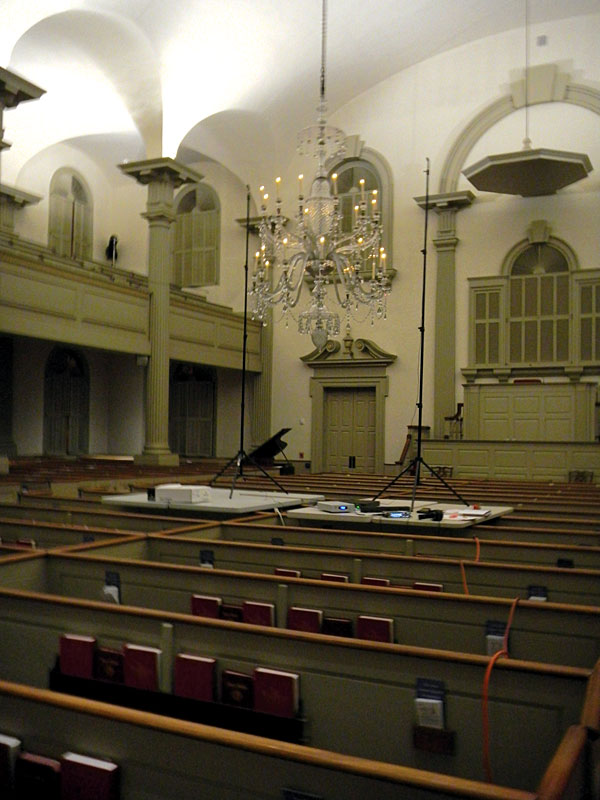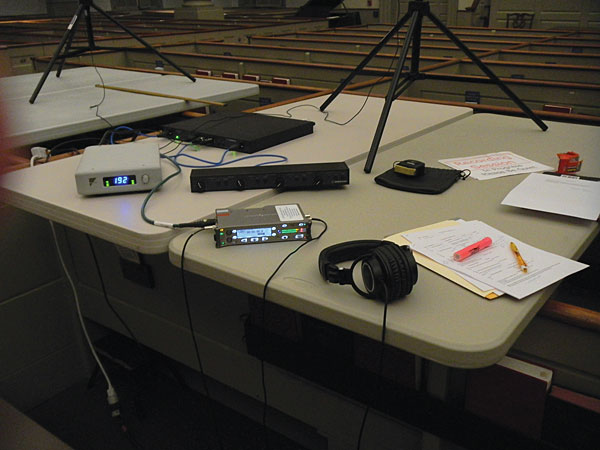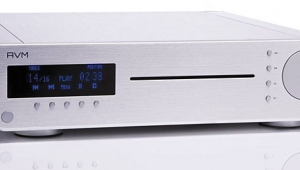| Columns Retired Columns & Blogs |
The Fifth Element #78

Reading the November 2012 Stereophile, my eye was caught by John Atkinson's very enthusiastic review (he bought the review sample) of Ayre Acoustics' new QA-9 analog-to-digital converter. Over and above the intrinsic interest of the QA-9's claimed flat response down to about 1Hz, and that it is a cutting-edge ADC from a maker of consumer rather than professional audio gear, I had just been engaged by early-music scholar and organist Beverly Jerold to produce and engineer a recording of historically informed performances of Baroque organ music by Buxtehude (b. 1637), Clérambault (b. 1676), J.S. Bach (b. 1685), and Domenico Scarlatti (b. 1685). The recording venue was the Auditorium of the Third Meeting House of the First Baptist Church in America, in Providence, Rhode Island.
Footnote 1: The Sound Devices Model 702 digital recorder contains its own mike preamps and ADCs, which are not shabby at all, but I bypassed those functions for this project. The 702's role was to archive the digital data sent by the Ayre QA-9 via a Cardas AES/EBU cable.
The Third Meeting House, built in 1774–1775, was designed as a slightly smaller and far less ornate version of the famed Anglican Church of St. Martin-in-the-Fields, London, which is now known for having hosted, in 1959, the first of many performances by Neville Marriner's Academy of (then) 11 strings, and from which that ensemble took its name.
Owing to its barrel-vaulted ceiling of horsehair plaster, First Baptist Church shares the excellent acoustics of St. Martin-in-the-Fields. However, I had come to suspect that, despite having recorded there many times, I had not come close to getting into the Sound Devices Model 702 digital recorder's CF memory card all that Third Meeting's Auditorium and organ were capable of. This time, I resolved to go all out.
The first two challenges involved Third Meeting House itself. The city of Providence grew up around the building, which is a stone's throw from the Providence River, the financial district, the Rhode Island School of Design, and Brown University. The main bus tunnel to the East Side is about 100' away, and there is a major bus stop right in front of the Meeting House. In short, in terms of having any real quiet in which to make a recording, forget about it. A partial solution was to record late on the Sunday night of the three-day Veterans Day weekend, with a make-up session the following evening.
The second challenge was that, as usually set up, the Auditorium's acoustic is rather dry. That's great for speech intelligibility, but for music, the short reverberation time can give the sense, on playback, that the room is too small for the organ, or the organ too big for the room. I'd been giving that a lot of thought earlier in the year as I prepared to engineer a CD celebrating the congregation's 375th anniversary. I experimented with removing first some, and then all, of the thick, heavy (and doubtless anachronistic) horsehair pew cushions, which had been installed in 1904.
Wow. What amazingly effective acoustical absorption is provided by some 1260 square feet of three inches' depth of ancient horsehair padding! I think it fair to say that both Minister of Music and organist Stephen Martorella and organ builder Mike Foley were gobsmacked by how the sound just opened up. Judging by eye the before and after waveform plots produced by the Amadeus Pro II DAW software, going from horsehair cushions to bare hardwood roughly doubled the length of the reverb tails.
The next issue involves the physics of the operating principles of differing microphone designs, and what that means in terms of the sound captured at different mike positions. I've written about this before, so for reasons of space, this treatment must be telegraphic. There's no question that directional, velocity-transducer, microphones such as figure-8 ribbons and cardioid condensers are absolutely essential for "purist" stereo recording. However, as far as capturing the lowest frequencies, the fact that the diaphragms of nearly all directional microphones are exposed to the pressure of the soundwave on both sides means that, below a certain frequency, such mikes begin to exhibit self-cancellation.
Nondirectional (omnidirectional) pressure-transducer microphones are exposed to the soundwave pressure on only one side, and therefore have much greater bass extension. The drawback is that pressure transducers' nondirectionality means that, to map the soundstage, omni microphones must be widely spaced. It is the wide separation of omni mikes that provides amplitude- and time-difference information that makes possible, on playback, the re-creation of a soundstage (dissenters might add, "of sorts").

In "Stereo and the Soundstage," his "As We See It" for December 1986, JA wrote: "Recordings made with widely spaced microphones are analogous to Impressionist paintings: wonderfully pleasing to the eye and capable of evoking a deep emotional response, but when you get right down to it, hardly realistic in literal terms."
Even though I love the sense of locked-in center image that mid-side or ORTF miking gives, in this case I wanted to capture all the bass and all the space. Omni mikes it had to be.
Jerry Bruck, of New York City's Posthorn Recordings (www.posthorn.com), came through with a pair of Schoeps CCM-2s omnis. I plugged them into the church's regular recording system in place of their PML CC-22s. While to my ears it wasn't exactly a slam dunk (the PMLs are very fine microphones), the Schoepses captured an authoritative solidity and an obviously larger sense of space. Mastering engineer Alan Silverman, however, did think it was a slam dunk in favor of the Schoepses.
Ayre Acoustics then provided me with a QA-9 ($3950). Because a separate ADC requires an analog microphone preamplifier to provide it with a line-level signal, I then had to find a mike preamp (footnote 1). Boston-area classical recordist Micha Shattner graciously lent his Gordon Instrument Model 5 Microphone Preamplifier System, with a claimed bandwidth of 2Hz–300kHz ($2900 for the two-channel version). As far as I know, the Model 5 is unique in that its gain adjustment, in 5dB steps, switches among separate amplifier modules, each pair optimized for its particular 5dB increment. Compared to the usual approach of running the amplifier-module circuits wide open and then attenuating, this solution claims advantages of true variable gain without attenuators or loop feedback, as well as automatic (analog) output-stage load compensation. (While Gordon's website is bare bones compared to Ayre's, the design rationales of the companies' products are strikingly similar.)
I experimented with microphone positions, mostly in terms of distance from the organ pipes. I was looking for the best possible balance of compromises in detail, blend, and bloom. I ended up with the mike stands on folding tables bridging two ranks of pews, the mikes spaced 2m/78" apart, ca 14' above the floor, and about 25' back from the organ case, in a space 80' square with an average ceiling height of about 55'.

In addition to recording, in 24-bit/192kHz PCM, Beverly Jerold's program of Baroque music, I recorded Steve Martorella playing two of his favorite 20th-century organ showpieces: Charles Hubert Parry's setting of Blake's "Jerusalem," and Otto Emanuel Olsson's Jul, made famous (in some circles) by Oscar's Motet Choir's Cantate Domino (LP/CD, Proprius 6672). I found the combination of Schoeps omni mikes, Gordon Model 5 mike preamp, and Ayre QA-9 ADC stunning. The effect, while monitoring through headphones, was similar to a much more powerful amplifier driving much more capable speakers.
In order that as many people as possible can hear what I believe is the first live location classical recording made with Ayre's QA-9, you can find a free download of an MP3 of Steve Martorella's performance of Olsson's Jul here By the time you read this, I will have made arrangements abut selling hi-res files. For info, click here.
The Beverly Jerold project is now at Alan Silverman's studio for mastering. I'll keep you posted.
Beethoven's Revenge?
As soon as I mentioned a relatively obscure boxed set of Beethoven's string quartets (by the Orford Quartet, on Delos) as having long been my favorite performances, two new, extremely worthy recordings of the composer's late quartets appeared. But before I talk about them, I want to explain why I think string quartets remain so important. I believe there are four reasons for the past and continuing significance of the string quartet.
First, the string quartet is one of the few musical ensembles that can play reliably in tune in all musical keys. Since the era of Pythagoras (ca 580–500 BC), the complications of pitch intonation, scales, tunings, and temperaments have constituted the most daunting set of technical problems in music—see my February 2007 column.
The full development of the string quartet in the 1750s for the first time allowed composers to create harmonic tension by letting the music explore even the most remote keys without sounding out of tune—which, before the triumph of equal temperament, would have been the case with any ensembles that included a keyboard.
Second, a string quartet is capable of performing music at the outer limit of the complexity that even a trained listener can comprehend, at least in one pass. Orchestras are bigger, but in terms of the essential nature of the music and its inherent level of complexity, orchestration is often just a matter of the composer's wanting different tone colors, wider dynamics, or different sound effects than a string quartet can provide. Writing for an orchestra is not usually a matter of expressing musical complexity beyond the capability of a string quartet.
Footnote 1: The Sound Devices Model 702 digital recorder contains its own mike preamps and ADCs, which are not shabby at all, but I bypassed those functions for this project. The 702's role was to archive the digital data sent by the Ayre QA-9 via a Cardas AES/EBU cable.
- Log in or register to post comments




































